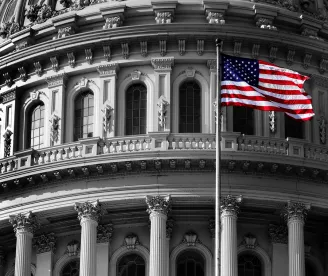Spring Regulatory Agenda Issued. On May 22, 2019, the Office of Information and Regulatory Affairs (OIRA) released the administration’s Spring 2019 Unified Agenda of Regulatory and Deregulatory Actions. Before diving into the regulatory morass, there are a few items of note regarding these regulatory agendas. First, as one might imagine, in order to publish something this lengthy, each agency likely submitted its respective agenda weeks or even months ago. Second, these deadlines are often aspirational, so these target dates may not be accurate. Set forth below are a few highlights of what we can expect in the regulatory arena in the months ahead.
U.S. Department of Labor (DOL)
-
Overtime, Joint Employer, Regular Rate. Unfortunately, the Wage and Hour Division (WHD) did not provide any timeline for when final rules on these matters may issue (more on the overtime matter below).
-
Association Retirement Plans. The Employee Benefits Security Administration is scheduled to issue a final rule in June 2019 “which would allow small businesses to band together to offer 401(k) plans to their employees.”
-
FMLA Regulations. In April 2020, the WHD is slated to issue a request for information (RFI) to “solicit comments on ways to improve its regulations under the FMLA.” Yes, this is 11 months in the future, but the Family and Medical Leave Act (FMLA) and its attendant issues (e.g., intermittent leave) continue to vex employers, so this bears watching.
-
OFCCP Transparency. In September 2019, the Office of Federal Contract Compliance Programs (OFCCP) will propose “to codify certain procedures and documents OFCCP uses to resolve potential violations of these laws by federal contractors and subcontractors.” This likely refers to various memoranda that OFCCP has issued over the last several months regarding transparency and efficiency of its investigations.
United States Citizenship and Immigration Services (USCIS)
-
H-4 EAD. USCIS is forecasting that it will issue a proposal to “remove from its regulations certain H-4 spouses of H-1B nonimmigrants as a class of aliens eligible for employment authorization” by the end of May 2019.
-
H-1B Reform. In August 2019, USCIS is expected to issue a proposal to revise the definitions of “specialty occupation,” “employment,” and the employer-employee relationship, as well as additional changes “designed to ensure employers pay appropriate wages to H-1B visa holders.”
-
H-1B Registration Fee. In July 2019, USCIS will propose a fee requirement for H-1B registrations pursuant to its recently finalized electronic registration rule.
National Labor Relations Board
-
Joint Employer. Final action on the Board’s joint-employer proposal has been relegated to the “Long Term Actions” section of the agenda, which is reserved for initiatives in which the “agency does not expect to have a regulatory action within the 12 months after publication of this edition of the Unified Agenda.”
-
Union Representation Procedures. A proposed regulation addressing the Board’s standards on blocking charges, voluntary recognition, and Section 9(a) bargaining relationships in the construction industry is expected to issue in August 2019. The more generalized RFI on representation election regulations has been moved to “long term actions.”
-
Access Rule. In September 2019, the Board will issue a proposal “to establish the standards under the National Labor Relations Act (NLRA) for access to an employer’s private property.”
-
Student/Employee Status. In September 2019, the Board will issue a proposal“to establish the standard for determining whether students who perform services at a private college or university in connection with their studies are ‘employees’” under the NLRA.
Equal Employment Opportunity Commission
- A new proposal regarding employer-sponsored wellness programs and their treatment under both the Americans with Disabilities Act of 1990 and the Genetic Information Nondiscrimination Act of 2008 is slated to be released by December 2019.
National Mediation Board
- A final rule regarding union decertification under the Railway Labor Act is scheduled to be released by the end of May 2019.
OT Docket Closes. May 21, 2019 was the deadline for the public to submit comments in response to the DOL’s WHD’s proposed changes to the overtime regulations. As a reminder, the WHD is proposing to set the salary basis threshold at approximately $35,000 per year. The next step will be a final rule, which the WHD will be racing to promulgate, lest it get caught up in 2020 election politics. Litigation will no doubt follow, regardless of when the rule is finalized.
New COS at the DOL. Last week, the Buzz discussed the resignation of DOL Chief of Staff Nicholas Geale. This week, the DOL promoted Molly Conway to assume the chief of staff role effective June 1, 2019. Conway is currently both deputy chief of staff and acting assistant secretary for the Employment and Training Administration.
Equality Act Advances. On May 17, 2019, the U.S. House of Representatives passed the Equality Act by a vote of 236 to 173. Eight Republicans voted yes, while zero Democrats voted no (though seven abstained). The Equality Act would prohibit LGBTQ discrimination in employment, housing, public accommodations, and other fundamental areas. Prior to the vote, a group of over 60 trade associations called for passage of the Equality Act, indicating that the bill enjoys the support of the larger business community. Of course, even with that significant support, the Equality Act will face tough odds in the U.S. Senate.
OSHA LOTO RFI. No, this isn’t an eye exam chart, but a reference to the Occupational Safety and Health Administration’s (OSHA) recent publication of an RFI regarding its lockout/tagout (LOTO) safety standard. Specifically, the RFI “seeks information regarding two areas where modernizing the Lockout/Tagout standard might better promote worker safety without additional burdens to employers: control circuit type devices and robotics.” According to a press release that accompanied the RFI, OSHA is seeking information from the regulated community
…about how employers have been using control circuit devices, including information about the types of circuitry and safety procedures being used; limitations of their use, to determine under what other conditions control circuit-type devices could be used safely; new risks of worker exposure to hazardous energy as a result of increased interaction with robots; and whether the agency should consider changes to the LOTO standard that would address these new risks.
Comments are due by August 18, 2019.
To Defer or Not to Defer, That Is the Question. Mark your calendars, administrative law geeks. On June 13, 2019, the Historical Society of the District of Columbia Circuit will host a program on the Chevron doctrine, which will “feature a re-enactment of the arguments over EPA’s interpretation of an ambiguous provision of the Clean Air Act presented in NRDC v. Gorsuch, 685 F .2d 718 (1982).” Note that this isn’t even a reenactment of the oral arguments in the U.S. Supreme Court case that established Chevron deference. Rather, it’s a reenactment of the D.C. Circuit case that was appealed to the Supreme Court and that resulted in the famous decision, so this is really getting into the administrative law weeds. While the Buzz isn’t sure how the whole lawyers-as-actors thing will turn out, we applaud the participants for tackling an important—and complex—issue.
(And yes, that is Anne M. Gorsuch, mother of Supreme Court Justice Neil Gorsuch, who was head of the Environmental Protection Agency at the time.)
The Buzz will be off next week but will return on June 7.




 />i
/>i
